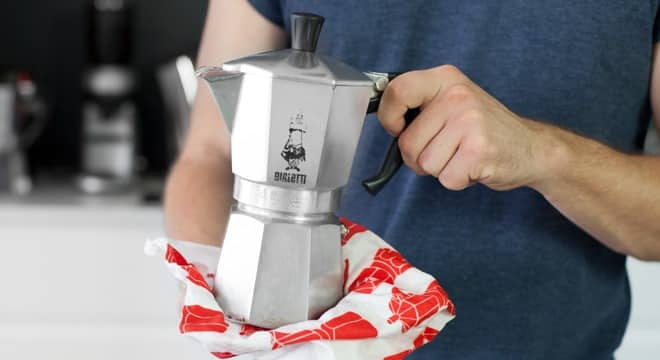The beauty of the Moka Pot not only resides in the amazing coffee it has the potential of producing but also in how painfully simple it is to take care of them. Since they are not by any means fancy pieces of engineering but smart and practical gadgets, they are pretty easy to maintain, which adds to the experience of owning one of these classic pieces.
For starters, you should know that before you drink a cup of coffee brewed in your brand new pot, it is important to brew a few batches. You will not drink these, but discard them. The point is to seal the inner surface of the pot with the different oily components coffee beans naturally have, in order to avoid getting coffee with a metallic aftertaste. Aluminum is not toxic and it is present in many of the foods we ingest daily, but it does leave an unpleasing and lingering taste when the gadgets are not properly sealed.
Once you have your pot all nice and coated, you will want to keep it that way, meaning the washing is just as important as the brewing if what you are looking for is a great cup of Joe. Wash your Moka Pot with water, rinse it carefully and wipe it with a soft cloth. Leave it in the drying rack for a bit so you make sure the inside dries completely before you put it away. These tips will ensure that the period of time in which your Moka Pot will be useful and functional is the longer possible.
If the Moka Pot is your go-to coffee brewing instrument, the oily coat you gave it when you first got it will eventually go rancid. That’s OK and only natural. This is when soapy, hot water gets in the picture. You will have to scrub your pot thoroughly, only to start the process all over again with the instructions and tip we previously provided.
Since these pots are made out of aluminum (at least the classic ones), the outside needs to be taken care of just like the inside. Wipe any excess water with a cloth and let it dry before putting it away. If you store a Moka Pot that is even slightly damp, you are not just risking the oily coating you so carefully prepared, but you are also taking a chance with stains. Water stains aluminum, and with just a little bit of attention you will be able to avoid this. The only way to remove this brownish stains is to, once again, give the pot a good scrub, which is something (as we said) you will want to avoid most of the time.
This is very practical advice, but we also think is important to put some myths to rest. There has been some rumors circulating that say aluminum is a harmful material and is best to avoid it. Well, we took it upon ourselves to do a little research. We are fans of the classic aluminum Moka Pot and thought it would be a shame if a little bad press made them fall out of use.
Because aluminum is the most abundant metal on earth, it is a very cheap material from which a lot of things are manufactured. Moka Pots among them. Overall, most of the rumors surrounding the so called “hazards of aluminum” are unfounded, have been discredited or only affect people who are in constant contact with this substance (mine workers for example). Generally speaking, a human consumes little amounts of aluminum that can be found in food and drinks, but this will not pose a threat to said person’s health.
No one likes to hear they are unknowingly ingesting metal with every meal, but these amounts are so little that are not considered harmful at all, and there is no real proof that aluminum causes any disease or affliction whatsoever. Do not worry, we would never recommend something that could be remotely unsafe.
So, as you can see, Moka Pots are fairly easy to maintain, and just with this handful of tips you will be able to enjoy yours for a long time. If you want, you can consult for further information in the following links we are providing for you: http://www.yuppiechef.com/spatula/cleaning-your-moka-pot/, http://www.thekitchn.com/-good-questions-182-137468. If you are interested in knowing more about the properties of aluminum and its effect on humans, check this useful website: http://www.atsdr.cdc.gov/phs/phs.asp?id=1076&tid=34.
